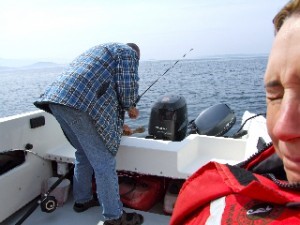 If time permits while you are whale watching and if there is a shortage of suitable food back at the lodge your guide may jig up a few bottom fish to feed the camp eagles. The guest reaction to the fact that I must “knock” the fish on the head is often a mixed response. As much as they want to see an eagle fed there is a certain amount of sympathy for the fish. Karen and Martin visiting from the UK provided this photo.
If time permits while you are whale watching and if there is a shortage of suitable food back at the lodge your guide may jig up a few bottom fish to feed the camp eagles. The guest reaction to the fact that I must “knock” the fish on the head is often a mixed response. As much as they want to see an eagle fed there is a certain amount of sympathy for the fish. Karen and Martin visiting from the UK provided this photo.
Whale Watching
We’re not all about the bears, whales are abundant here too!
Killer whales and humpback whales are often seen during our wildlife tours. There are resident whales and transient whales that can be seen feeding and playing in our waters.
Black Bear on a Whale safari
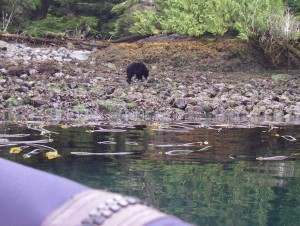
Every tour is a black bear tour. The first evening in the lodge there is a tour to familiarize guests with the boats and guides and to look for wildlife in particular black bears. But every trip leaving the lodge to look for grizzly bears, orcas, humpback whales or to the wild river on the extra day in camp we look along the shore for feeding black bears. If you have a decent camera you will get some good photos. The above photo gives you some perspective of how close we approach a feeding bear showing the boat top over the windshield in the lower corner. The camera a small ten times optic zoom Pentax with no zoom used.
Humpback Lunge Feeding 2 of 2
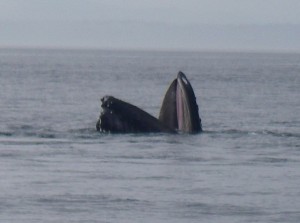
This past summer more of the humpback whales viewed were doing a vertical lunge. The whale would come up slowly with its mouth wide open and often remain as shown in this photo and slowly rotate in a circle for up to a minute. It would then slowly close its mouth, hopefully full of herring, and sink below the surface. It must have worked because it was viewed often over the summer.
Humpback Lunge Feeding 1of 2
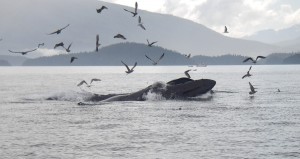
Lunge feeding humpback whales are common on the whale watching trips that leave Grizzly Bear Lodge most days. This sideways lunge will on occasion catch more that herring. After the lunge the whale sinks and forces the water out through the baleen leaving the herring trapped and to be swallowed. Sometime a duck or seagull will exploded several a meter (yard) or two out of the water in to the air having escaped becoming whale food. Those that escape seem to be little worse for wear and continue to feed.
Killer Whales also fish
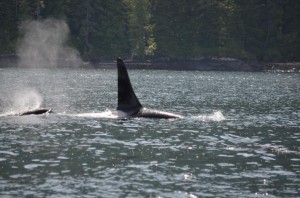
The post from yesterday with the seine boat netting salmon is in direct competition with today’s killer whales fishing. I have found over the years that during the commercial fishing season, which is not much, more that two weeks the orca stay away from the areas containing the fishing boats. Fortunately the commercial fishing area is a small portion of the viewing area for orca and humpback whales. In a way it is helpful in that it eliminates some area from our search grid and helps to locate the humpbacks and killer whales a little faster.
Summer “Food Fish”
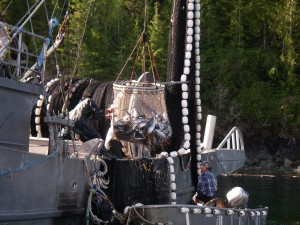
Not all of the time on the whale watching safari trips is necessarily spent watching wildlife. Once the wildlife viewing is satisfied there are often other interesting activities occurring. On this day it was a commercial seine fishing boat. They had set their nets and after about an hour they are required to pull them in and empty their catch before resetting. Once the net is close to the boat they use a bailing net to remove the salmon and on this day they emptied about eight bail nets full. A reasonable catch for a few hours work.
Humpback whale feeding
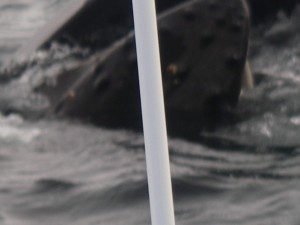
While parked within photo range of a herring ball it is important to remember that humpback whales have and excellent sense of their environment. They will surface close to the boat but they are aware that you are in the area. The other important point is not to be moving while you are waiting or the whales will not know your position. In this case the whale was close enough that it was impossible to focus the camera and those with long lenses were lost. The June 5th posting is a much better distance.
Seagulls feeding
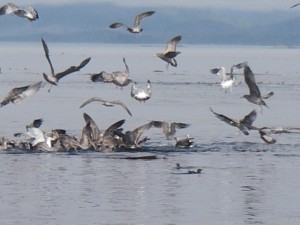
Feeding seagulls are important to guides on whale watching tours. The feeding gulls signal that there is a herring ball near the surface. The herring ball up as a defense to the diving ducks that feed on the herring. This ball rotates to the surface and attracts the gulls, which in turn attracts your guide to park the boat in the area and to wait for the humpback whales that feed on the herring… more tomorrow
Killer Whale Visiting
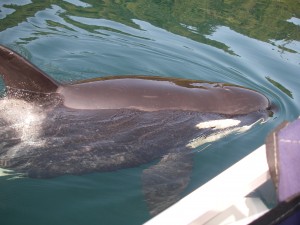
Every day on the whale watching safari trips that leave Grizzly Bear Lodge is different. On the day of this picture we were sitting several hundred meters (yards) off shore as a pod of orca were passing. The whale watching guidelines specify that you are to be two hundred meters from the shore if whales are in shore of your boat or one hundred meters in open water. The regulations are in force by an organization known as Strait Watch and on this day they were less than seventy-five meters behind our boat. One of the whales in the pod turned from the shore and surfaced beside our boat, swam around the boat and then under the boat and resurfaced on the other side. Strait Watch came over after the orca had moved on and were interested in our pictures, they thought that the orca was fishing under the boat and became curious as dolphins are by nature interested in their surroundings. The reason is not as important as the great pictures.
Almost a complete white head
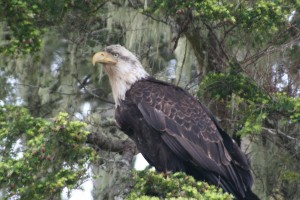
Great photo of a young bald eagle. Young because eagles start to get their whites heads in their third year and are normally fully white by the end of the fifth year. Regarding the yellow beak I found an interesting story on line from Senior Naturalist Dave Erler that is worth reading:
“Not long ago a Squam Lakes Natural Science Center trail visitor observed the immature and adult Bald Eagles housed at the Raptor Exhibit and asked me a great question. Why does the adult Bald Eagle have a yellow beak? I pondered for a moment before responding. I recollected from the ornithology course I took in college that the outer covering of a bird’s beak was composed of keratin, which is similar to keratin in mammal nails or claws, reptile scales, and bird feathers. I also explained that the yellow color in bird beaks, ceres (the fleshy portion at the base of a raptor’s beak), and feet are caused by pigments called carotenoids. After sharing this information, I explained that when I first came to work at the Science Center some three decades ago, most of the raptors in our collection had very dull color in their ceres and feet. This prompted me to contact a veterinarian I knew who worked with raptors. The vet explained to me that the carotenoids in bird beaks have a slightly different composition of proteins and glycine than is found in other animals. The yellow color is influenced by both diet and hormones. The vet suspected the dull color was the result of a vitamin deficiency, possibly vitamin E. On the vet’s recommendation we began to use a vitamin supplement formulated for hawks and falcons. After a few months, there was a marked improvement of the birds’ ceres and feet, indicated by a brighter yellow color.
After sharing all this information with this gentleman, I could tell by his glassed-over eyes that I had missed the intention of his question. So I asked him if his question was really, “What is the function of having a yellow beak?” He nodded yes. Realizing I had already bored him senseless, I simply stated it probably indicates to other eagles that the individual is fully mature and healthy, important factors if you are trying attract a mate and hold a territory. That answer was sufficient and he wandered off leaving me to wonder why I don’t have a yellow beak.”
